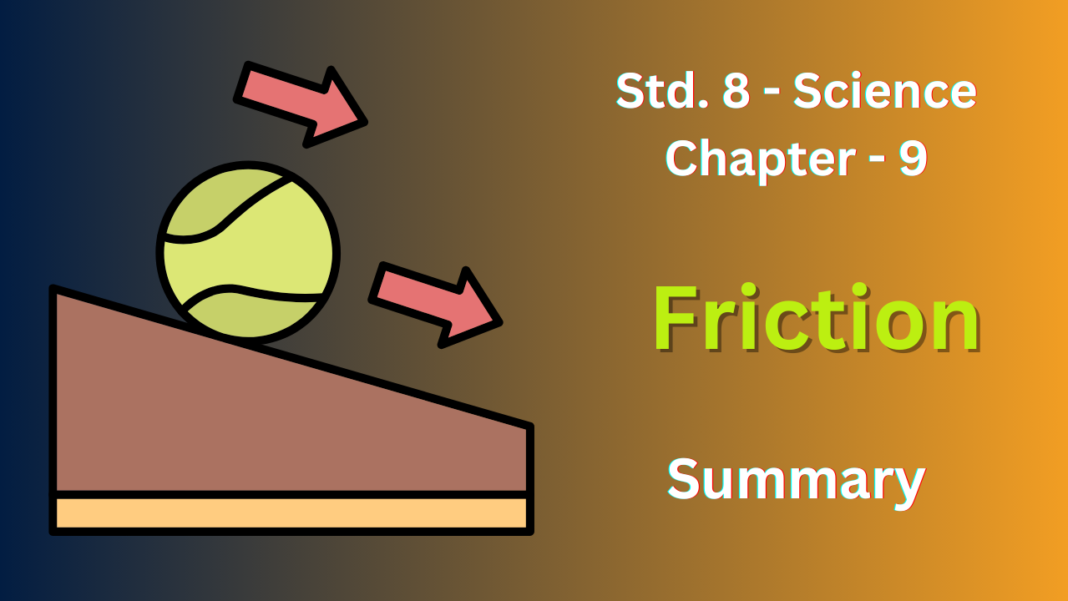NCERT Solutions for Class 8 Science Chapter 9
- It’s the force that acts against the movement of an object when it’s in contact with another surface. Imagine it as a force trying to slow things down.
- There are two main types:
- Static: This one comes into play when you’re trying to get an object to start moving. It’s like the force that keeps a book on a table from sliding off.
- Sliding : Once the object is moving, this takes over. It’s usually a bit less than static . Think about the sensation when you rub your shoes on the ground while walking.
- It isn’t all bad! It helps us walk, write, and even stop a car with brakes.
- But it can also be a pain. It causes wear and tear on machines and shoes, and it can generate unwanted heat.
- To reduce it, we use lubricants like oil or grease. They make surfaces smoother, so there’s less resistance for objects to slide over them.
So, it is a double-edged sword. It can be both helpful and harmful, depending on the situation.
Q1. Fill in the blanks. –
(a) Friction opposes the ______ between the surfaces in contact with each other.
(b) Friction depends on the ______ of surfaces.
(c) Friction produces ______
(d) The sprinkling of powder on the carrom board _______ friction.
Ans:
- Motion
- Nature
- Heat
- Reduce
Q2. Four children were asked to arrange forces due to rolling, static and sliding frictions in decreasing order. Their arrangements are given below. Choose the correct arrangement.
(a) rolling, static, sliding
(b) rolling, sliding, static
(c) static, sliding, rolling
(d) sliding, static, rolling
Ans: static , static , rolling
Q3. Alida runs her toy car on a dry marble floor, wet marble floor, newspaper and towel spread on the floor. The force of friction acting on the car on different surfaces in increasing order will be
(a) wet marble floor, dry marble floor, newspaper and towel.
(b) newspaper, towel, dry marble floor, wet marble floor.
(c) towel, newspaper, dry marble floor, wet marble floor.
(d) wet marble floor, dry marble floor, towel, newspaper.
Ans: (d) wet marble floor, dry marble floor, towel, newspaper.
Q4. Suppose your writing desk is tilted a little. A book kept on it starts sliding down. Show the direction of frictional force acting on it.
Ans: It will act upward i.e the direction opposite to that of sliding book
Q5. You spill a bucket of soapy water on a marble floor accidentally. Would it make it easier or more difficult for you to walk on the floor? Why?
Ans: Soap makes floor slippery = less friction = harder to walk.
Q6. Explain why sportsmen use shoes with spikes
Ans: Spikes grip the ground better, like tiny claws. This helps athletes run faster, turn quicker, and perform better on soft surfaces.
Q7. Iqbal has to push a lighter box and Seema has to push a similar heavier box on the same floor. Who will have to apply a larger force and why?
Ans: Seema will have to apply a larger force.
This is because of inertia. Heavier objects have more inertia, which means they resist changes in motion more than lighter objects. To overcome this inertia and get the heavier box moving, Seema needs to apply a larger force.
Q8. Explain why sliding is less than static friction
Ans: Imagine rough surfaces like interlocking hooks (static ). To slide them, you only need to overcome those hooks once (sliding ), making it less force.
Q9. Give examples to show that friction is both a friend and a foe.
Ans: It can be both a friend and a foe, depending on the situation. Here are some examples:
Friend:
- Walking: It between your shoes and the ground allows you to grip and propel yourself forward.
- Writing: It between the pen and paper lets you leave a mark.
- Lighting a match: It between the matchstick and the striker strip creates heat to ignite the match.
- Braking a car: It between the brake pads and wheels slows down the car.
Foe:
- Shoes wearing out: Friction between your shoes and the ground causes them to wear down over time.
- Machine parts getting worn: Friction between moving parts in machines can wear them down, requiring maintenance and replacement.
- Fuel inefficiency: Friction in car engines creates heat and reduces fuel efficiency.
- Difficulty walking on ice: Low friction on icy surfaces makes it hard to walk without slipping.
Q10. Explain why objects moving in fluids must have special shapes.
Ans: Objects moving in fluids (liquids or gases) need special shapes to minimize drag force. Here’s the connection:
- Drag force: This is the opposing force a fluid exerts on a moving object. Imagine pushing your hand through water – you feel resistance, that’s drag.
- Shape matters: Objects with blunt or irregular shapes create more turbulence (disruption) in the fluid as they move. This turbulence increases drag force, making it harder for the object to move through the fluid.
- Streamlined shapes: These are special shapes like teardrops or fish bodies that are narrow at the front and wider at the back. They smoothly cut through the fluid, creating less turbulence and reducing drag force. This allows the object to move more efficiently with less effort.
FAQ’s
How does friction affect motion?
It acts as a resistance force that opposes the motion of objects in contact with each other. It reduces the speed of moving objects and generates heat energy due to the interaction between surfaces.
Can friction be beneficial?
Yes, it plays a crucial role in several aspects of our daily lives. For example, it helps in walking by providing the necessary grip between our shoes and the ground. It also allows us to write with a pen or pencil and enables vehicles to stop when brakes are applied.
What are the different types of friction?
The main types of friction are static, kinetic , and rolling friction. Static occurs between stationary objects, kinetic occurs between moving objects, and rolling occurs when an object rolls over a surface.
How can we reduce friction?
It can be reduced by using lubricants such as oil or grease between surfaces, polishing or smoothing the surfaces to make them more slippery, or by using wheels .
What topics are covered in Class 8 Science Chapter 9?
Chapter explores the concept of friction comprehensively. It covers various aspects such as types of friction, factors affecting, methods to reduce , and its practical applications in everyday life.









